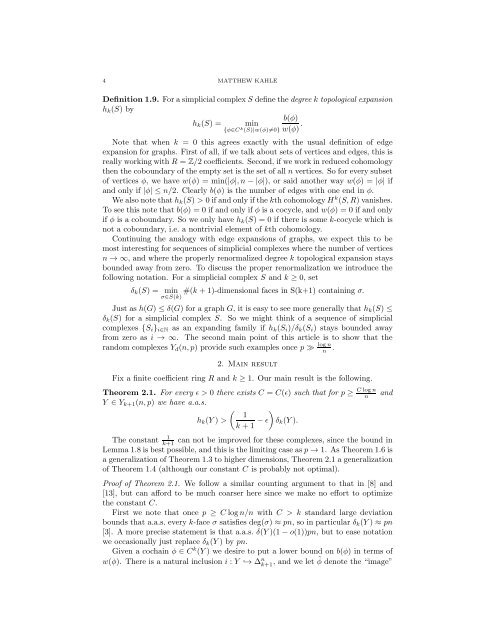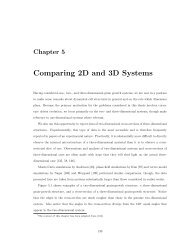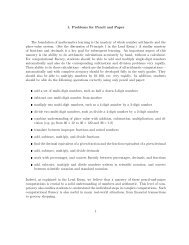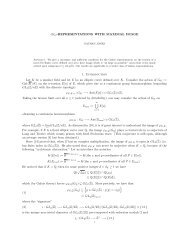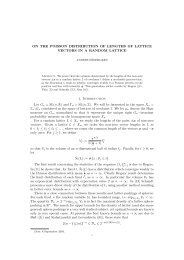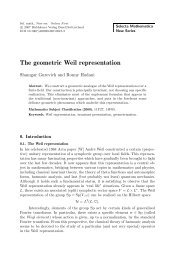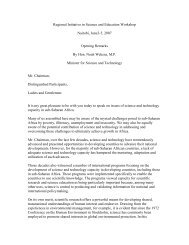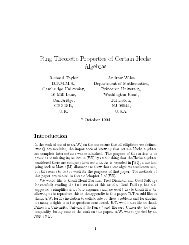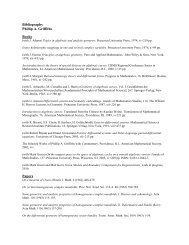TOPOLOGICAL EXPANDERS 1. Introduction Expander graphs ... - IAS
TOPOLOGICAL EXPANDERS 1. Introduction Expander graphs ... - IAS
TOPOLOGICAL EXPANDERS 1. Introduction Expander graphs ... - IAS
You also want an ePaper? Increase the reach of your titles
YUMPU automatically turns print PDFs into web optimized ePapers that Google loves.
4 MATTHEW KAHLE<br />
Definition<strong>1.</strong>9. ForasimplicialcomplexS definethedegree k topological expansion<br />
h k (S) by<br />
b(φ)<br />
h k (S) = min<br />
{φ∈C k (S)|w(φ)≠0} w(φ) .<br />
Note that when k = 0 this agrees exactly with the usual definition of edge<br />
expansion for <strong>graphs</strong>. First of all, if we talk about sets of vertices and edges, this is<br />
reallyworkingwith R = Z/2coefficients. Second, ifweworkin reducedcohomology<br />
then the coboundary of the empty set is the set of all n vertices. So for every subset<br />
of vertices φ, we have w(φ) = min(|φ|,n −|φ|), or said another way w(φ) = |φ| if<br />
and only if |φ| ≤ n/2. Clearly b(φ) is the number of edges with one end in φ.<br />
Wealsonotethath k (S) > 0ifandonlyifthekth cohomologyH k (S,R)vanishes.<br />
To see this note that b(φ) = 0 if and only if φ is a cocycle, and w(φ) = 0 if and only<br />
if φ is a coboundary. So we only have h k (S) = 0 if there is some k-cocycle which is<br />
not a coboundary, i.e. a nontrivial element of kth cohomology.<br />
Continuing the analogy with edge expansions of <strong>graphs</strong>, we expect this to be<br />
most interesting for sequences of simplicial complexes where the number of vertices<br />
n → ∞, and where the properly renormalized degree k topological expansion stays<br />
bounded away from zero. To discuss the proper renormalization we introduce the<br />
following notation. For a simplicial complex S and k ≥ 0, set<br />
δ k (S) = min #(k +1)-dimensional faces in S(k+1) containing σ.<br />
σ∈S(k)<br />
Just as h(G) ≤ δ(G) for a graph G, it is easy to see more generally that h k (S) ≤<br />
δ k (S) for a simplicial complex S. So we might think of a sequence of simplicial<br />
complexes {S i } i∈N as an expanding family if h k (S i )/δ k (S i ) stays bounded away<br />
from zero as i → ∞. The second main point of this article is to show that the<br />
random complexes Y d (n,p) provide such examples once p ≫ logn<br />
n .<br />
2. Main result<br />
Fix a finite coefficient ring R and k ≥ <strong>1.</strong> Our main result is the following.<br />
Theorem 2.<strong>1.</strong> For every ǫ > 0 there exists C = C(ǫ) such that for p ≥ C logn<br />
n<br />
and<br />
Y ∈ Y k+1 (n,p) we have a.a.s.<br />
( ) 1<br />
h k (Y) ><br />
k +1 −ǫ δ k (Y).<br />
1<br />
The constant<br />
k+1<br />
can not be improved for these complexes, since the bound in<br />
Lemma<strong>1.</strong>8isbest possible, andthisis thelimiting caseasp → <strong>1.</strong> As Theorem<strong>1.</strong>6is<br />
a generalization of Theorem <strong>1.</strong>3 to higher dimensions, Theorem 2.1 a generalization<br />
of Theorem <strong>1.</strong>4 (although our constant C is probably not optimal).<br />
Proof of Theorem 2.<strong>1.</strong> We follow a similar counting argument to that in [8] and<br />
[13], but can afford to be much coarser here since we make no effort to optimize<br />
the constant C.<br />
First we note that once p ≥ Clogn/n with C > k standard large deviation<br />
bounds that a.a.s. every k-face σ satisfies deg(σ) ≈ pn, so in particular δ k (Y) ≈ pn<br />
[3]. A more precise statement is that a.a.s. δ(Y)(1−o(1))pn, but to ease notation<br />
we occasionally just replace δ k (Y) by pn.<br />
Given a cochain φ ∈ C k (Y) we desire to put a lower bound on b(φ) in terms of<br />
w(φ). There is a natural inclusion i : Y ֒→ ∆ n k+1 , and we let ˜φ denote the “image”


